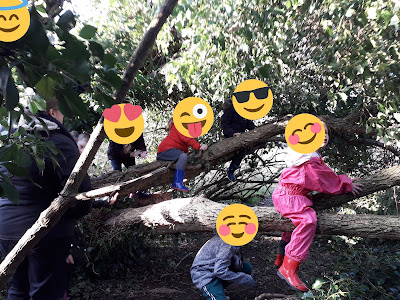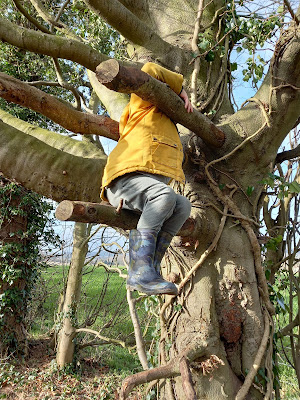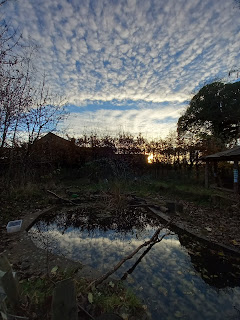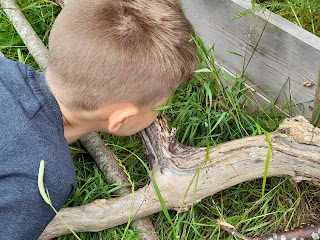Assess Risk
Like in all practices, in Forest School, how you do things alters over time. Some of it is a slow evolution as your own confidence grows, a lot of it is simple trial and error, and much of it varies between groups you work with. The better you know the children in your sessions, the more you tailor what you are offering to them. For a while, I thought I only aimed what I offered based on the age group I had at Basecamp, but it's become increasingly obvious over the years that it's more to do with the experiences the children bring to sessions.
Moving from an urban setting to a significantly more 'rural' one meant some surprising adaptations for me, the main one being how the pupils at school took their trees and open spaces for granted. They could easily be immersed in nature just a block or two from their front doors, but this didn't mean they appreciated it or treated green spaces with respect. In London, the children cherished their time in the woods and were eager to preserve it, probably because it was a place they had limited time in and they appreciated the environment when they got to explore it. In Kent the children were not awed by the space, could walk through the space and not notice much of the wildlife around them. This was when I became more interested in Nature Connection, it was automatic in the city, an appreciation of a different environment and an eagerness to visit it more. In the suburbs of a Kent town, the children are used to seeing it, they take a lot for granted, the importance of the spaces around them needs to be highlighted.
Swiftly behind adjusting to a totally different attitude to being outside in Forest School came the significant change of being in a school with no Nursery Class. In London, the 3-year-olds did full two-hour sessions and after a few weeks were the quickest to change clothes, to line up, to get to the gates of the wooded area! When they started Reception class they were old hands at it, ready to explore more, to focus on other activities because they understood the basics so well. I have had to adapt to viewing the Reception Class that way I would've the Nursery Class. They've had no prior experience of Forest School, they are still learning the skills my previous cohorts learned in Nursery: Listening, sitting still, working together etc. This was obviously never perfected! But I've learned that previous experience in wildlife and in Outdoor Learning dictates a session much more than age group.
Now that I'm starting my third year at Chartham School, the children are very used to doing Forest School with me. Years R - 4 have never had a different Forest School Leader and Years 5 & 6 are very used to the way I do things. In turn, I know them pretty well as we navigate our third year together. Covid never brought a break in provision, in fact, we stepped up how much outdoor time we offered to pupils, so while I still do not have 400+ names secure in my head, I have a very good idea about the ability of the classes, and most of the individuals.
This year, I have started making the children more aware of what their role in Forest School is, particularly when it comes to safety.
We recite the Forest School Rules at all sessions. Sometimes I say them, sometimes the children say them, sometimes we go for a shorthand reminder. Now we also include whose job it is to keep everyone safe.
The children are beginning to understand that they are the first risk assessors, that knowing the safe way to climb a tree is for their benefit and not a means to slow them down. If they want to independently climb it can only happen if I trust them to do so safely, and if they know how to climb safely. I will be close by, but we have a lot of space, and if I'm called away I may not have time to wait for them to climb back down!
The realisation of this responsibility has been met by a lot more maturity than was expected!
We often expect children to take responsibility without actually giving them any. Yes, climbing a tree is dangerous. No, I don't fully trust them all to shimmy up (or down) safely! But I have learned how adept the classes are at climbing, and that (rare) accidents only happen when they are impatient, or not concentrating. So I thought it was time to make it clear to them that being allowed risky activities depends on their behaviour.
The Children are slowly learning that the first person to keep you safe in Forest School is yourself. For younger children, this mostly means looking out for prickles and stinging nettles, they do climb, but it is relatively low level, and I do remain close to the trees/bushes that they use the most to ensure they are supervised. What seems obvious to us, such as "make sure no one else is in the 'tree' first", needs voicing regularly!
We are also taking on the idea that friends are probably the next people to keep an individual safe. Your peers may notice something unsafe before you do. A mate can run to get adult help if you think you need it. There are Grown-Ups at Forest School, but they may not be nearby, so you need to make sure you're as safe as possible before you take a risk.
Older classes are told that this is 'Risk Assessment' and that they may have to explain their thinking when making a decision!I'm working on a Tree Climbing Leaflet for the older classes. There are other risky activities in Forest School but they are not so independent.
All children are taught 5 basic rules to climb:
- Choose your tree carefully
- Tell an adult you are going to climb
- Plan a way up in your head
- Only climb on branches as thick as your wrist or thicker
- Climbing relies on 2 hands, 2 feet, 2 knees and a bottom! Always have at least 3 of those body parts on the tree!










Comments
Post a Comment